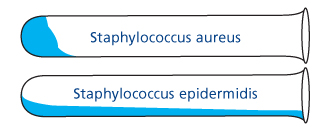Introduction
Some species of staphylococci, notably Staphylococcus aureus in humans and Staphylococcus intermedius and Staphylococcus hyicus in animals, are associated with acute infections. The organisms can all clot plasma and this ability, due to the presence of the enzyme coagulase, is widely used as a criterion for identification of these pathogens, Coagulase production is very closely linked with the capability of S. aureus to form enterotoxins.
The coagulase test can be used to detect both free coagulase and bound coagulase(clumping factor).
The tube coagulase test may be used to identify coagulase positive staphylococci including methicillin resistant strains, provided that only a firm clot (one that does not move when the tube is tipped) is considered a strong positive result.
BioConnections Rabbit Plasma contains EDTA as an anti-coagulant in preference to citrate because citrate-utilising organisms such as Pseudomonas species, Serratia marcesens, Enterococcus faecalis and strains of Streptococcus are able to clot citrated plasma in 18 hours, and can produce false positive results.
The slide agglutination test has an approximate 96% agreement with the tube coagulase test. However, the slide agglutination technique can occasionally generate false-positive results. This is due to the fact that some strains, such as S. lugdunensis and S. schleiferi subsp. Schleiferi, produce clumping factor resulting in a positive slide test only.
The tube coagulase method can be used to differentiate these species from S. aureus. In addition, spontaneous agglutination may occur on the slide agglutination test, when rough cultures are used. When the slide test is employed, all negative slide reactions must be confirmed by the tube test.

